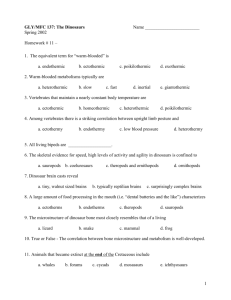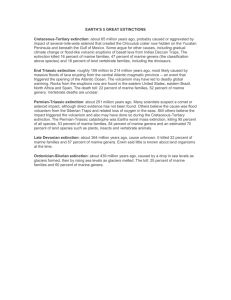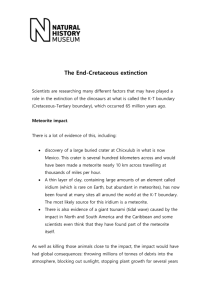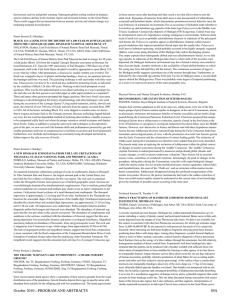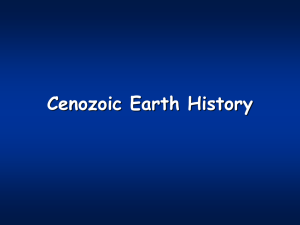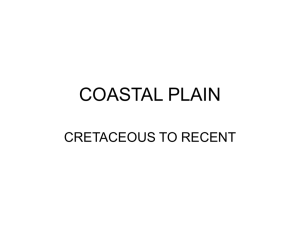The Paleozoic Era
advertisement
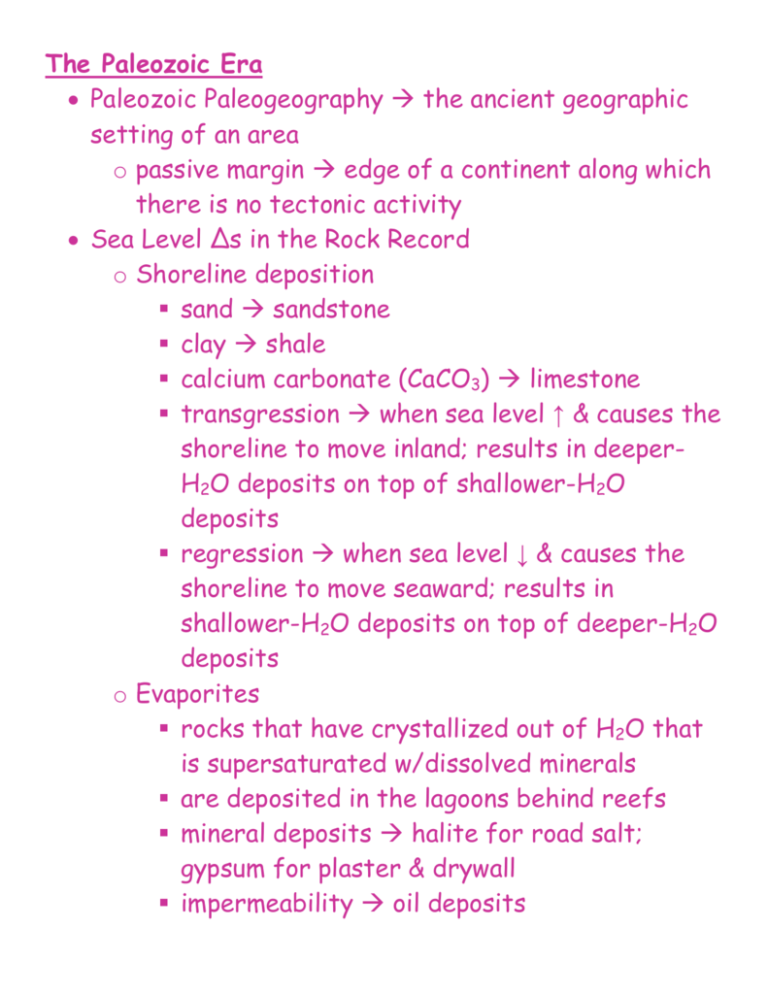
The Paleozoic Era Paleozoic Paleogeography the ancient geographic setting of an area o passive margin edge of a continent along which there is no tectonic activity Sea Level Δs in the Rock Record o Shoreline deposition sand sandstone clay shale calcium carbonate (CaCO3) limestone transgression when sea level ↑ & causes the shoreline to move inland; results in deeperH2O deposits on top of shallower-H2O deposits regression when sea level ↓ & causes the shoreline to move seaward; results in shallower-H2O deposits on top of deeper-H2O deposits o Evaporites rocks that have crystallized out of H2O that is supersaturated w/dissolved minerals are deposited in the lagoons behind reefs mineral deposits halite for road salt; gypsum for plaster & drywall impermeability oil deposits o Glaciation transgressive & regressive cycles glaciers lower sea level Mountain Building - Ordovician Period Taconic Orogeny (mountains in New York) o Laurentia (core of modern-day North America) deformed Ouachita Orogeny collided w/Gondwana (present-day Africa & South America) Alleghenian Orogeny formation of the Appalachian Mountains @ the end Pangaea Paleozoic Life - multicellular organisms w/hard parts o Cambrian explosion sudden appearance of a diverse collection of organisms in the Cambrian fossil record o Ordovician extinction more than ½ the marine groups that appeared became extinct why? glaciation o Devonian extinction new marine groups: fish, other vertebrates, tetrapods on land another extinction ~ 50% of marine groups why? global cooling/glaciers o Terrestrial plants survived extinctions (seeds) coal deposits plants lived in swamps, died, sediment added = coal large insects o Permian Δs Permo-Triassic Extinction Event @ end, largest mass extinction ever; extinction of ~ 95% of marine life-forms affected marine & terrestrial life > 65% of amphibians almost 1/3 of all insects why? a combo of: o ↓ in sea level o extreme volcanism o low atmospheric O2 levels o meteorite impact The Mesozoic Era Mesozoic Paleogeography o Breakup of Pangaea middle of Triassic Period heat caused expansion cracks climate was warm no glaciers o Seaways ocean flooded the rift valleys Atlantic Ocean & Mid-Atlantic Ridge formed Red Sea & Gulf of Aden new seaways in East Africa o Δing sea level ↑ in sea level @ beginning sea level ↓ @ end of Triassic sea level ↑ again during Jurassic & continued into Cretaceous Mountain Building - along Laurentia’s west coast (not much on east coast) o Cordillera Spanish for “mountain range” 3 phases: 1st phase late Jurassic & early Cretaceous steep, slow subduction volcanism occurs near coast formed the Sierra Nevadas 2nd phase during Cretaceous shallow, faster subduction massive thrust faults inland tectonic activity started forming Rocky Mountains 3rd phase – late Cretaceous & into Cenozoic very fast, very shallow subduction lack of volcanism tectonic activity moves inland w/large vertical uplifts Mesozoic Life - new marine organisms large predatory reptiles - phytoplankton microscopic organisms that are the basis of marine food chains; abundant during the Cretaceous & the remains of their shell-like hard parts are found in chalk deposits worldwide o Plant life tall cycad trees seed plants w/out true flowers ginkgos, pine trees, & other conifers flowering plants in Cretaceous o Terrestrial animals mammals appeared in late Triassic reptiles were dominant amniotic egg egg w/a shell, providing a complete environment for a developing embryo + Dinosaurs o most reptiles have a sprawling posture o archosaurs many dinosaurs had an upright posture o Mass extinction terrestrial dinosaurs, most marine reptiles, plants, & many other organisms why? combo of: massive volcanism (stressed climate) large meteorite impact @ end of Cretaceous (@ least 10km in diameter) o maybe in Mexico’s Yucatan Peninsula o iridium metal that is rare in rocks @ Earth’s surface but is relatively common in asteroids The Cenozoic Era Cenozoic Paleogeography ~ 1.5% of Earth’s total history (~ the last 66 million years) o Cooling trend occurred when Australia split apart from Antarctica during the Eocene caused by a Δ in ocean currents o Miocene warming Antarctic ice cap melted was reversed in the mid/late Miocene Arctic Ocean began to freeze set the stage for the ice ages o Ice ages started in late Pliocene & continued throughout the Pleistocene @ peak, glaciers up to 3km thick covered ~ 1/3 of Earth’s land surfaces glaciers: carved out lakes & valleys dropped huge boulders left behind deposits of clay, sand, & gravel Cenozoic Mountain Building - erosion wore down the Rockies, but uplift continued o Subduction in the West Farallon Plate began a steep subduction beneath the Pacific Northwest for the Cascade Mountains (active volcanoes today) North American Plate + Pacific Plate = San Andreas Fault transform boundary little volcanism o Basin & Range Province in SW US & northern Mexico consists of 100s of nearly parallel mountains formed when stresses in Earth’s crust pulled it apart still continues today o Continental collisions Paleocene Africa collided w/Eurasia created the Alps Paleogene India crashed into Asia formed the Himalayas o Tectonic forces continue are warm now may become cooler in future some think that we may have another supercontinent in 250 million years Cenozoic Life - clams, sea urchins, & sharks survived the mass extinction @ the end of the Cretaceous - forests dominated the landscape - climate cooled in the late Eocene grasses appeared - late Oligocene grasslands & savannas - Age of Mammals o Ice age mammals late Pleistocene woolly mammoth & sabertoothed cat Homo sapiens species to which modern humans belong o Humans - bipedal walking upright on 2 legs - 1st bipedal humanlike primates appeared ~ 6 MYA during the late Miocene - fossil remains of earliest modern humans (Africa) are ~ 195,000 years old Migrations influenced by the ice ages of the late Pleistocene North America’s 1st inhabitants maybe walked across the Bering Strait
